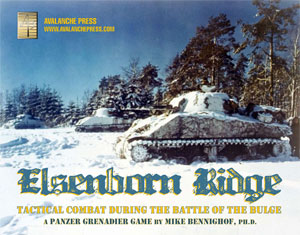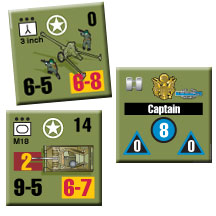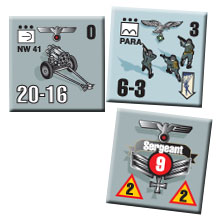| Elsenborn
Ridge:
Scenario Preview, Part One
By Mike Bennighof,
Ph.D.
June 2020
 Elsenborn Ridge is the oldest game still in the Panzer Grenadier lineup; those that came before didn’t make the transition to the Fourth Edition for various reasons, mostly because they just weren’t good enough to meet the standard that we’re trying to set for all of our games. Elsenborn Ridge, on the other hand, has what I consider the best scenario set in the series, despite having been designed by me. Elsenborn Ridge is the oldest game still in the Panzer Grenadier lineup; those that came before didn’t make the transition to the Fourth Edition for various reasons, mostly because they just weren’t good enough to meet the standard that we’re trying to set for all of our games. Elsenborn Ridge, on the other hand, has what I consider the best scenario set in the series, despite having been designed by me.
Its age makes Elsenborn Ridge somewhat of an outlier among the series games; the scenarios aren’t formally organized into chapters like the most recent titles, nor does it have any battle games to link the scenarios together. We never gave it the scenario preview that other games received, just a few random scenario intros slapped onto the website. Let’s fix that, and look more closely at the first handful of them:
Scenario One
Autumn Mist
16 December 1944
After a brief artillery bombardment, the Germans sent infantry divisions forward as the first wave of the attack known as Operation Herbstnebel, or Autumn Mist. These units would open the way through the American defenses for the panzer divisions to exploit deep into the Allied rear. At least that was the way it had been drawn up on Sixth SS Panzer Army's planning maps.
Conclusion
Using searchlights directed at the low-hanging cloud cover, the Germans created what they called "artificial moonlight" to enhance visibility. It could not, however, enhance the willingness of the raw Volksgrenadiers to stand up to American firepower. The advance made some initial headway, forcing the 393rd Infantry Regiment's Company K to surrender and surrounding the rest of the regiment's 3rd Battalion. But the American defense rallied and the German attack stalled.
Design Notes
This is just a small scenario to start things off; the stats at Panzer Grenadier HQ show that Scenario Number One is almost always the one played the most. It’s a solid intro to the game system, with a minimum of special rules though you do have to keep up with increasing visibility. The Germans are badly outgunned except for artillery support in the early turns about equivalent to the High Seas Fleet.
 Scenario Two Scenario Two
An Operation Named Mist
16 December 1944
While part of the Volksgrenadier division struck down the Schwarzenbruch Trail toward the village of Krinkelt, another regiment attacked into the woods to the south in hopes of flanking the American defenders. The Germans had numbers on their side, but the Americans had not been surprised.
Conclusion
The initial German bombardment did little damage to American positions in this sector, and the advancing Volksgrenadiers walked into a torrent of rifle and machine-gun fire. A single barefoot BAR gunner killed over a dozen Germans. But German numbers told and the assault had begun to make headway by mid-morning, when the Americans threw in their last reserve, the regimental anti-tank minelaying platoon. Lt. Harry Parker led his men in a wild, screaming bayonet charge, and after he skewered one Volksgrenadier dozens of others threw down their weapons and fled.
Notes
This is a slightly larger scenario than the last, also featuring improving visibility and a Great War style opening artillery barrage. The Germans have numbers, too, but their troops would rather be elsewhere. The Americans are outnumbered but well-supported, so they can hold their ground if they play well.
Scenario Three
Dismal Failure
16 December 1944
The northernmost attack of the Ardennes offensive targeted the town of Höfen, which stood directly on the front lines. The rough terrain here would not support a panzer drive, but Sixth SS Panzer Army considered it important to secure the wooded hills here. The road leading northward from Elsenborn needed to be broken, to make it difficult for the powerful American divisions around Aachen to strike southward into the German flank.
Conclusion
The German assault met disaster, as the Americans had carefully prepared their artillery fire plan and called down devastating shellfire on top of the attackers. No American position was taken, and the German division suffered massive casualties. It pulled back from the front and played no further role in the Battle of the Bulge, its combat effectiveness utterly destroyed in a few hours.
Notes
Thanks to that truly excremental 1960’s Battle of the Bulge movie, there’s this false notion floating around that panic-stricken American troops ran away at the battle’s start. That’s not true; the Americans here are well-prepared and despite the huge artillery barrage that starts the game the German player is going to have to play really well to make headway with these crapulent attackers.
Scenario Four
Second-Hand Lions
16 December 1944
The German battle plan had been formed based solely on situation maps, but when patrols discovered that a green American infantry division had been inserted into the line Fifth Panzer Army command altered its approach. The "Golden Lions" of the 106th Infantry Division had been raided to provide replacements for other divisions' combat losses. Hastily re-trained anti-aircraft gunners, washed-out pilot trainees and men of the Army Specialized Training Program filled the ranks instead. On the German side, the assault would be undertaken by the "ethnic Germans" of the 62nd Volksgrenadier Division - Czech and Polish conscripts with little enthusiasm for their enemy's Fatherland.
Conclusion
Col. Friedrich Kittel had grand plans for his division: it would tear a gap in the American lines and his bicycle-mounted reserve battalion would dash through to capture St. Vith and the trains loaded with gasoline he imagined waiting there. Though the American defenders were inexperienced, Kittel's troops were even worse - to get them to attack his officers had had to ply them liberally with alcohol and then lead from the front. Officer casualties were massive and progress was made only through sheer weight of numbers.
Notes
The Americans aren’t very good, but the Germans are truly terrible and they don’t have the massive artillery advantage of the prior scenarios. They do have a great many unwilling conscripts to throw into the breach, so this one’s going to be tough on the Americans.
Scenario Five
Collision
17 December 1944
The initial failures in the northern sector did not bode well for the German offensive. The roads had to be opened for the panzer divisions to meet their very ambitious objectives. Knowing it would weaken his drive later, corps commander Hermann Preiss ordered some of his tanks forward to assist the volksgrenadiers; if the American lines could not be breached, there would be no use for the panzer forces later. Meanwhile, the Americans had received tank and infantry reinforcements of their own and were determined to restore their lines.
Conclusion
The American and German attacks crashed into each other, generating surprise on both sides and saying little for either's scouting and preparation. The German attack had greater numbers behind it, and once a battalion of Panther tanks joined the fight, they pushed the Americans back. But the Germans were still far behind schedule.
Notes
Finally, we get a tank battle! The Americans have plenty of strength to hold their line at first, but those Panthers are going to be hard to handle when they eventually reach the battlefield. Fortunately the planning for this battle was done by the SS, so the Americans will only have to fend off the heavy metal for about the last third of the game.
 Scenario Six Scenario Six
Twin Villages: The First Night
17 December 1944
Frustrated over his division's lack of progress, Hugo Kraas of 12th SS Panzer ordered his youthful soldiers to continue their assault after dark. The shattered Volksgrenadier battalions pulled back into the woods to re-form, while the Americans had been reinforced by Lt. Col. William McKinley's battalion of the 2nd Infantry Division and some tank destroyers.
Conclusion
The Germans had numbers and armor on their side; the Americans had stubbornness and a massive concentration of artillery: seven artillery battalions with 112 guns backed the defense, though communication with McKinley's forward observers had been lost. The grandson of President William McKinley held his positions through the night despite repeated German attempts to take the vital crossroads, and by midnight the Hitler Youth had seen their attack break down.
Notes
And now we begin the saga of the epic battle for the Twin Villages. I do wish I had this game to do over, to break out these scenarios (and some others like the Crossroads and St. Vith sequences) into their own chapters with nice deep background and a battle game.
Scenario Seven
Twin Villages: Valor and Sacrifice
18 December 1944
Repelled by the furious American defense and overwhelming firepower, the young SS volunteers of the Hitler Youth re-formed to assault the "twin villages" of Krinkelt and Rocherath again at dawn. The SS unit could not advance to the west without securing the vital crossroads, yet as occurred at several other points during the Battle of the Bulge the positions took on an importance completely detached from operational reality as men fought and died in and around the small stone buildings. This time, the SS division committed its full panzer regiment.
Conclusion
Aided by their tanks, the panzer grenadiers finally made progress into the American positions, many of them taken only through point-blank cannon fire. But with the Americans having re-established communications with their artillery battalions, the massive rain of shells inflicted enormous casualties on the SS. At one point an American infantry company commander called down artillery fire on his own position - a step that sounds dramatic in movies, but in practice is utterly devastating. All but 12 of the riflemen were killed. Around noon a heavy barrage allowed McKinley's battalion to pull back into the twin villages; close to 3/4 of his initial force had become casualties.
Notes
Like the last scenario, this one features one board with a lot of pieces on it. While Elsenborn Ridge has “generic” geomorphic maps like the other games, I designed this board (Number 23) specifically for the Twin Villages scenarios, so it actually is a “real terrain” map that’s a little fudged to send the roads off the edges at the points common to the other boards in the series.
Scenario Eight
Twin Villages: Panzer Graveyard
18 December 1944
With the Lausdell crossroads in German hands, the SS could finally strike at the twin villages themselves. The panzers assaulted the stone buildings directly, backed by their own panzer grenadiers and Army infantrymen of the 12th Volksgrenadier Division, a veteran outfit despite its title. Inspired by McKinley's stand and the awesome artillery support, the Americans fought for every room of every building in both villages.
Conclusion
Punishing artillery fire had gutted the SS panzer grenadier battalions during the morning battle, but rather than await help from other formations 12th SS simply sent its tanks against the villages with little to no infantry support. American bazooka teams took a fearful toll of German armor in the narrow village streets: 60 by German admission, over 100 by American claims. The arrival of Volksgrenadier infantry eased the tank slaughter somewhat, but when night fell the Americans still held most of the villages.
Notes
The Germans are pretty tough, but the Americans are tougher and this time they’re the ones with a couple of battleships’ worth of artillery (which, unlike the opening German barrage, they get to use for the entire game). Even so there are a lot of Germans with a lot of tanks, so this one’s going to be a brawl for all concerned.
And that’s it for the first segment of Elsenborn Ridge scenarios.
Click
here to order Elsenborn Ridge right
now!
Sign up for our newsletter right here. Your info will never be sold or transferred; we'll just use it to update you on new games and new offers.
Mike Bennighof is president of Avalanche Press and holds a doctorate in history from Emory University. A Fulbright Scholar and NASA Journalist in Space finalist, he has published over 100 books, games and articles on historical subjects.
He lives in Birmingham, Alabama with his wife, three children and his dog, Leopold.
|
